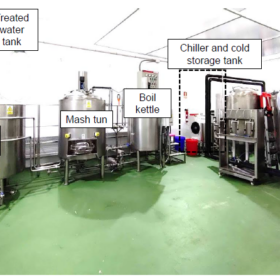Solar for small-scale brewing
Researchers in Spain have investigated the potential of using photovoltaic (PV) or photovoltaic-thermal (PVT) systems in microbreweries and have found that PVT systems can cover more energy demand but have a longer payback time.
TBEA launches new 1,500 V string inverter
TBEA has developed a new 1,500 V string inverter with a maximum efficiency of 99.02%, maximum power point tracking (MPPT), a maximum input current of 65 A, and a maximum short circuit current of 115 A.
How to make seaports into energy communities with PV, wave energy
Researchers have simulated the operation of seven renewable energy communities in the Port of Naples and found them to offer lower life cycle costs. Using varying capacities of solar and wave energy, they were able to optimize the system to a 90% self-consumption rate. They also offered a scheme for the management of a port energy community.
Optimal size ratios for solar, wind-powered hydrogen production
Researchers in Italy outlined a new model for estimating hydrogen production cost as a function of the plant’s component sizes. They tested both PV, wind, and hybrid production of hydrogen to determine the optimal size ratio for the 2030-2050 period. They also found that PV-powered hydrogen may currently achieve a levelized cost of hydrogen of €5.11/kg in Italy, with a PV ratio of 2.2.
Semi-transparent PV window based on passive radiative cooling coating
Scientists have manufactured and analyzed a novel coating for semi-transparent photovoltaic glazing that reportedly offers remarkable energy yield and a low heat gain rate. Through outdoor experiments, the researchers also found the glazing also provides satisfactory high-quality indoor lighting conditions.
Photovoltaics for hydroponic greenhouses
Researchers in Iran have investigated the operation of a real solar-powered greenhouse in the Alborz province and have found that only 4% of the greenhouse’s roof needs to be covered with PV modules to meet demand for lighting and pumping water.
Korean researchers propose new design for aluminum frames used in glass-glass bifacial solar modules
Using a surrogate model for finite element analysis, the scientists have designed an aluminum frame for bifacial modules that reportedly minimizes deflection and production costs, without adding too much weight. Deflection can lead to cracking or delamination of ribbons inside the module, resulting in an increase number of damaged cells.
Israeli startup launches agrivoltaic pilot in desert with double-axis sun tracking
Agri-Light has launched its first pilot agrivoltaic project, using a two-axis solar installation on a rail system to move solar panels horizontally above a vineyard in the Negev Desert. The results are due this summer, and the company plans to build commercial projects in Israel and Spain next year.
Trina Solar begins mass production of 430-455 W full-black modules
Trina Solar says it has launched mass production of 430 W to 455 W full-black PV modules. The Vertex S+ panels have efficiencies of up to 22.8% and weigh 21 kg, with a 1.6 mm x 1.6 mm dual-glass design.
Recursive least squares algorithms to detect abnormal operation in PV systems
Scientists in Spain have implemented recursive least squares (RLS) algorithms for anomaly detection in PV systems and have found they can provide “more realistic and meaningful assessment” than traditional energy analysis.










